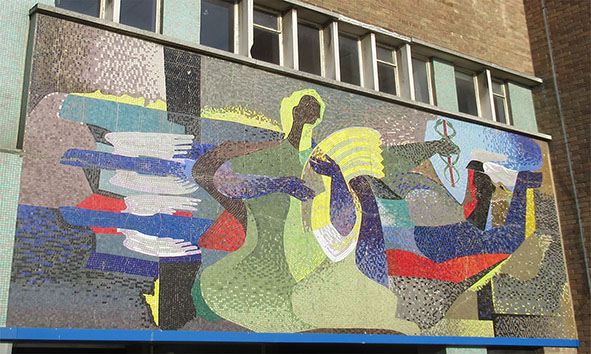- Screen Colours:
- Normal
- Black & Yellow
Co-op mural (‘Harvest’)

It is time to correct and supplement the information shown in our Public art in Ipswich booklet published in January 2021 and distributed free with this Newsletter. Now that the plans to develop as a school the site of the former Co-operative stores running east from Cox Lane down Carr Street have been approved, one proviso imposed by the Borough Council planners is that the developers should remove, restore and resite the large mosaic mural which can be found on the rear of the rather brutalist 1960s block and above Cox Lane (our cover image this issue).
Our entry in the booklet reflected the general opinion that the creator of this work of industrial art was not known – this was frustrating for me as the compiler of the booklet. However, Ed Broom, Mike Taylor and, more recently, Keith Wade have pointed to the work of architectural historian Lynn Pearson. Her 2020 book England's Co-operative Movement: An Architectural History (Historic England imprint of Liverpool University Press) makes a clear attribution:-
‘The final mural in the series was a collaboration between Gyula Bajo [1907-1984] and his old friend Endre Hevezi [1923-2017], probably carried out during 1963-4 and certainly complete by spring 1965. Designed for a site at the rear of Ipswich's modernised premises (1960-5, CWSAD*), it is a colourful and elegant mosaic mural, a stylised abstract representation of co-operation based around a female figure holding a wheatsheaf. Although further developments were planned for the area, nothing materialised and the mural now looks out over car parks and back entrances to anonymous buildings.’ (*Co-operative Wholesale Society Architects Department)
These two Hungarian refugees were talented ceramicists with architectural skills, but it appears that they did not work for CWSAD for very long. Our Ipswich mosaic is ‘one of only four surviving large-scale English Co-op murals from the 1950s and 1960s’ in the country. The name Harvest seems to have been attached to the work over time, associated to the central sheaf of corn, a typical symbol of the Co-operative movement. It can be difficult to untangle all the shapes and colours of this design, which harks back to the modernism of the 1930s to 50s.
One commentator refers to two doves of peace flying off to the left, a large brown bird and a Loch Ness monster-like sea creature on the right. However, what we have here are two figures: Ceres, goddess of the harvest, is central – her hair echoing the colour of the corn sheaf she holds. The figure of Mercury, the Roman god of commerce, lies, or floats, horizontally behind her. The feathery shapes on the left are his winged boots. As his body appears on the right, his hand holds a caduceus (herald's wand, or staff with intertwining snakes, as he is the messenger of the gods). His other arm and hand are raised, coloured dark blue. In between, we see the semi-profile in red and black of Mercury with his winged helmet. It looks as if he wears a long cloak which projects across to his feet.
It is good to supply an interpretation of the subject matter and, at last, an attribution to one of the largest works of public art in Ipswich (3 by 9 metres). For further information, see Ed Broom’s blog: www.freston.net/blog/index.php?y=2021&m=01&d=25.
Public art in Ipswich published by The Ipswich Society (now updated, as above) is available as a PDF dowload on this website.
In April 2022, with everyone taking their first cautious steps into ‘society’ – as most of us haven’t been able to for two years – The Ipswich Society is gradually doing likewise with our Awards, AGM, talks, guided walks and (ta-daah!) the return of Heritage Open Days in September. Our HOD officer, Neil Thompson (his details are on page 27) welcomes regular and new venues – do get in touch.
Robin Gaylard